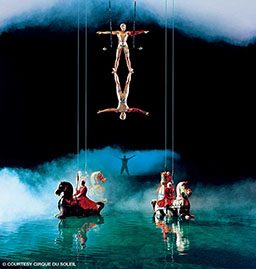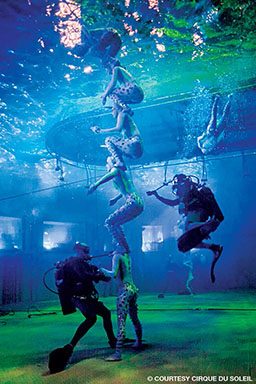It is 6:30 p.m. in Las Vegas, Nev. In a small office at the Bellagio Resort and Casino, the dive plan is called into action: “… Jorge as Philemon, Anja as Aurora, Benedict as Le Vieux … duo trapeze with the Alimovas … 15 artists in Barge ….” This is not a typical dive plan. At this briefing, members of the aquatics team are discussing the lineup for tonight’s performances of O by Cirque du Soleil. Meanwhile, 1,800 guests are filing into the theatre to witness the spectacle.
For more than 8,000 shows, the team of divers, known as artist handlers, has functioned as the show’s safety divers, trained its staff and given support behind the scenes and beneath the surface of “the stage” The stage is a 1.5-million-gallon, 25-foot-deep pool that is heated to 87°F and equipped with seven hydraulic lifts that allow the performance to take place anywhere from 18 inches above the surface to 17 feet below.
During each show 14 divers work in perfect synchronization — according to their own choreography — with what is happening on stage. They rely on guidance from “the crow’s nest,” a console 45 feet above the stage, in which a member of the aquatics team monitors six carpenter divers and two rigger divers. These divers are responsible for prop manipulation and scene set up and teardown, all of which they do while on scuba. Four other members of the aquatics team focus on supporting the artists by providing them air and swimming them to and from various places in the pool, which is integral to the theatre magic.

Two aquatics team members wear full-face masks and function as “divecomms.” These divers are in direct contact with the crow’s nest via hardwired communications — they observe firsthand what is occurring underwater and report any delays or maintenance needs to the crow’s nest. In the crow’s nest, the operator monitors seven closed-circuit television screens that show different views of the stage both above and below the water. The crow’s nest monitors the status of the pool and communicates with stage management about when it is safe to take the next cue to keep the show moving forward. Between artists and technicians, it takes nearly 200 people to put on the production that is O.
Though the name of the show is simple (O is the phonetic pronunciation of the French word for water, eau), the production is anything but. Before the show’s creation in 1997, there was no precedent for such a performance. The creators literally wrote the book that laid the foundation for this sort of production, and other shows around the world have since been modeled after O. The technical team is well versed in stagecraft, having worked on other shows in Las Vegas and around the world, but the aquatics team is unique to O.
The aquatics team, which is made up of divemasters and instructors with diverse experiences and backgrounds, includes recreational scuba professionals, engineers, commercial divers, search and rescue divers, boat captains and cruise ship workers.

The artist handlers’ job is quite different from that of a traditional stagehand. First and foremost, these divers focus on safety. The entire production team is proud of the show’s safety record. Aquatics team members frequently rehearse rescue procedures, emergency responses and contingency plans. Each team member completes a custom lifeguard training program as well as an American Red Cross Emergency Medical Response course. Aquatics team members also provide scuba training for their colleagues when the show requires it, training technicians as rescue divers and artists as basic confined-water divers. They also train the technicians in DAN’s Emergency Oxygen for Scuba Diving Injuries course.
The artist handlers’ diving rig is truly unique. Each diver has four second stages attached to the first stage: one for him or her and three to hand to artists as needed. In the pool, an additional 35 regulators are connected to a hookah system that artists can swim to and breathe from at any time. At one point during the show each artist handler has to support six synchronized swimmers while preparing to establish a platform for other artists. The artist handlers hand off two regulators from their rigs and carry small pony bottles with four more regulators for the artists to use.
Following the preshow briefing, divers conduct a series of in-water checks. The opening act is known as “Pied Deux,” which translates to two feet. The lifts are positioned 15 feet underwater, and a large red floating curtain lies on the surface. The aquatics team spreads out and places a matrix of 15 regulators, which are connected to a hookah system. Artists enter the water approximately three minutes before the show begins. As they swim to the center of the pool they receive regulators from the divers and are hidden from the audience until the show starts and the curtain opens. Once the artists are in position, the divecomms hit the cue lights to indicate that everyone is in position and the show can begin.

When the show starts, the lighting in the pool fades to black. Relying on ambient light, the divers watch the artists as they invert to begin Pied Deux and then drop the regulators from their mouths. When all the regulators are clear, the divers strike the hookah lines from the stage and stow them for their next use. This kind of sequence plays out many times. Each artist handler is responsible for his or her own “cue track,” a predetermined sequence of actions that take place during the show. Each cue track proceeds independently of the other cue tracks but is completely reliant upon the execution of the others. The aquatics department is responsible for six in-water cue tracks. Built into each cue track is a series of “catches,” which are some of the most difficult elements of a cue track.
During a catch, an artist enters the water from above, usually from an elevated platform. The crow’s nest watches and calls out the action over the underwater speakers. When the artist enters the water he holds his hands out and waits for the handler to give him a regulator. The artist then places the regulator in his mouth, purges it and swims with the diver to the next position or exit. At this point in the performance the diver and artist exhibit significant mutual trust. This trust is cultivated from the time a new artist or artist handler joins the show.
Cirque du Soleil artists are world-class athletes; some are Olympians with gold medals. They regularly perform feats such as a six-minute trapeze routine followed by a drop from 40 feet in the air into a pool where they await a regulator so they can take their next breath. The divers must be dynamic in the way they work underwater, responding quickly to unforeseen situations with artists.

O is a melting pot of talents, backgrounds and cultures, which brings challenges as well as rewards. Currently 20 countries are represented in the show, and the many native languages — not to mention regional scuba jargon and hand signals — often present communication challenges. Translators assist as needed to ensure information is clear and understood.
The O cast and crew are proud of their heritage and nationalities. A few times a year the entire team gathers for an international food day during which they bring a dish from their home countries. There is also a green room in which the artists and technicians gather for holiday parties, potlucks and sporting events. American football games are always popular, but international sporting competitions such as the FIFA World Cup or the Olympics bring particular excitement to the green room as everyone roots for his or her home country.
Due to the nature of show business, O team members often work on holidays and always perform on Saturdays and Sundays. The full schedule — there were 475 shows in 2015 — means cast and crew members must often miss birthdays, anniversaries and holidays with family. The O cast has become a second family for many team members, who celebrate holidays, births and marriages together.
As spectators exit the theatre, they leave with a vision that allows them to create their own story of O based on how it affected them. Ask cast members why they like working at O, and they often will say it is because of the people. While the aquatics team is just a small part of the show’s success, its role is vital for creating the spectacle that is O.
Explore More
© Alert Diver — Q2 Spring 2016